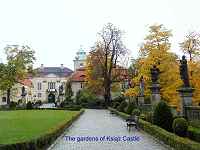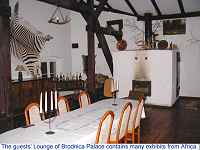PART 3 - South-west, Silesia - Pszczyna to Poznan.
We now entered Silesia, originally a province of Piast Poland, later under the rule of Bohemian princes, then the Habsburgs, finally in the 19th Century part of Prussia. In 1945 it returned to Poland. The small farms of Malopolska gave way to huge rolling estates almost devoid of forests. The character of the villages also changed. We quickly drove past Rybnik, Raciborz and Glogówek to the first town of interest.
13thC. Nysa was severely damaged by Soviet bombardment in 1945. But the massive, brick Gothic cathedral survived. It's soaring nave supported by brick columns is inspiring in its simplicity. The elaborate main altar survived because it was removed and hidden during WWII. Two other churches and several main buildings have been restored in their original form.
Just a few minutes further west, the lovely i6th and 17thC town of Otmuchów sits on the side of a hill between two lakes. Its large, open square, lying on a slope, serves as a natural amphitheater for concerts and festivals. The large castle, which once belonged to the bishops of Wrocław, looks down at the town. It has been beautifully restored and is now a hotel. The well decorated rooms, suites and public areas are furnished with period furniture and art work that take you back in time. It is so popular for wedding parties, that the county registry office is right there in the castle.
Paczków was built in the 13thC. Today, 700 years later, the city walls and gates remain virtually intact, like a miniature version of the French walled city Carcasonne. The street plan also remains unchanged, only a few more modern houses, and the automobiles upset the illusion of antiquity. Even the Gothic church is built like a fortress as it si in fact part of the ancient fortifications.
 Kłódzko (Klodzko) is dominated by a large 18thC. fortress on the site of an earlier 10thC. castle. The narrow streets of the town lead down to a Gothic bridge, lined with Baroque statues, which crosses the river to the Franciscan church in the valley. The church and the lower part of town suffered severe damage in the 1997 flood. In the church you can see markers indicating the depth of water in several floods that have occurred in the last centuries. The town lies at the mouth of a fan shaped valley surrounded by mountains of the Sudety range.
Kłódzko (Klodzko) is dominated by a large 18thC. fortress on the site of an earlier 10thC. castle. The narrow streets of the town lead down to a Gothic bridge, lined with Baroque statues, which crosses the river to the Franciscan church in the valley. The church and the lower part of town suffered severe damage in the 1997 flood. In the church you can see markers indicating the depth of water in several floods that have occurred in the last centuries. The town lies at the mouth of a fan shaped valley surrounded by mountains of the Sudety range.
Several spas offer curative waters in this valley, the best known is Kudowa Zdrój, which was even visited by Winston Churchill in the early 1930s. A bizarre attraction in this resort is the Chapel of Skulls built in 1776. The skeletons are those of victims of the Seven Years War and the subsequent plagues that decimated the population of the region. Buried in shallow graves they kept washing up to the surface. The local parish priest gathered them into this chapel and used some of them for shaping the altar. A nun will open the trapdoor to the cellar so that you may glimpse more mounds of skulls
The resort lies on the southern slope of the Table Mountains (Góry Stołowe) which are mostly within the National Park of the same name. Its characteristic feature are the fantastic rock formations. The road to Nowa Ruda takes you through the center of the park, and a side road leads up to a hostel with great views.
Świdnica was the capital of an independent Duchy in the 14thC. The Gothic Church of SS. Stanislaw and Wenceslas, dating back to that time, is richly decorated inside with both Gothic and Baroque chapels. Some fine late Renaissance houses line the Market Square, whose principal features are the column memorializing the victims of the Plagues and a fountain.
Take road #35 to Wałbrzych, stay in the right lane after passing Świebodzice and slow down. The entrance to Książ Castle is poorly marked and easy to miss. The castle, one of the largest in size in Poland, is a magnificent sight. It is situated in an extensive park on the edge of a cliff. The inside was denuded in WWII of all furniture and art work, first by the German army which constructed underground caverns for munitions and supposedly as a headquarters for Hitler. What was left was taken by the Soviets who used the castle as barracks. Therefore it is not worth the time it takes to go on a guided tour.
We stayed in the "Sudety" hotel in Wałbrzych. The room was well furnished and provided with good lighting (unusual for European hotels!). The mining town itself offers nothing of interest.
Unfortunately we were short of time and the weather was not promising, so we did not continue on to Jelenia Góra at the entrance to the many resorts of the Karkonosze Mountains. The town itself is picturesque with many charming buildings, but, in good weather, the scenery alone justifies the trip.
Our last stop in Silesia was the ancient town of Legnica, a rich Ducal capital in the 13thC. The large castle dates back to that time, but only a small part of the original structure remains after numerous reconstructions over the centuries. The large Gothic Cathedral of the same period towers over old arcaded houses in the Market Square and the Renaissance Town Hall.
Heading north-east towards Rawicz through Prochowice, you can see the extensive 17thC. Cistercian Abbey on the high bank of the Odra river.
 Entering the province of Wielkopolska, we stopped briefly at my old school, the Sułkowski Castle of Rydzyna. Beautifully restored after being burned down in an act of vandalism of the Soviedt army in 1945, it is worth an overnight stay. The town square built in the early 18thC. maintains its peaceful look to this day.
Entering the province of Wielkopolska, we stopped briefly at my old school, the Sułkowski Castle of Rydzyna. Beautifully restored after being burned down in an act of vandalism of the Soviedt army in 1945, it is worth an overnight stay. The town square built in the early 18thC. maintains its peaceful look to this day.
Our final night was a great pleasure. We stayed in Brodnica Palace. In 1996 the owner repurchased his ancestral home from the Polish state (which in Communist times had confiscated it) and turned it into a lovely, small hotel. We enjoyed the comfortable rooms, the wonderful ambiance and the excellent Polish cooking. Its location, 30km (20 miles) south of Poznan, makes it an ideal base for visiting the wonderful palaces in the area, such as Rogalin.
The extensive palace of the Raczynski family is now a museum. During this visit it was closed for renovations, we could only see the extensive collection of Polish 19th and early 20C paintings in the art galleries which are located in a separate wing. Our last stop was a visit of Kórnik Castle. Surrounded by a moat, the castle in its present 19thC. neo-Gothic style, survived the wars with its precious furniture and art collections intact. The last owners made a point of supporting local Polish artists and craftsmen. Visitors are provided with detailed descriptions of all the exhibits in several languages. We ended our visit with a walk around the park with its many species of trees and shrubs from all over the world.
